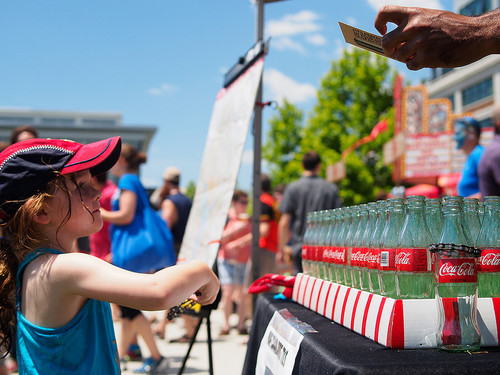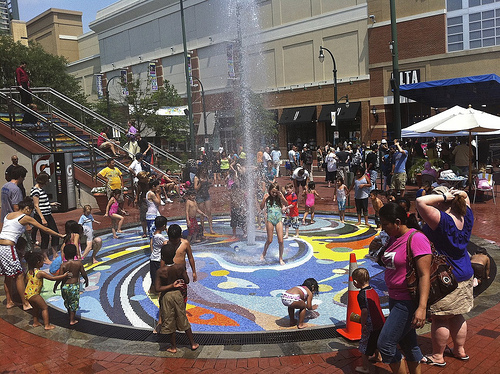If you want a place to welcome kids, make it urban
A child’s surroundings can make all the difference in what and how they learn, and urban places can offer what kids need for healthy development. Here are some ways we can make places kid-friendly.

Image courtesy of WABA.
While zoning meetings aren’t exactly a hot topic on parenting blogs, perhaps they should be. Our neighborhoods’ physical structure strongly influences how residents can raise children. Within the cultural conversation around the Meitiv’s, the Montgomery County couple who Child Protective Services investigated for allowing their children walk home from a park, little of it has been on how communities could make themselves better places for children.
With increasing proof that children need to be granted more independence and time outside, urban planning in the DC region and elsewhere needs to consider a key group of stakeholders: kids. Parenting and good community planning can go hand-in-hand for making our communities safer and better places for everyone to live.
Vibrant urban and semi-urban communities can offer families more options and flexibility. There are a number of smart planning strategies that can increase children’s safety and independence:
1. Make it easy to walk and bike
Parents won’t allow children to walk or bike if they feel the streets aren’t safe. Making real efforts to build wide sidewalks, maintain high-quality multi-use paths, and build protected bike lanes can provide assurance. In Austin, Texas, for example, a protected bike lane near an elementary school has helped bring the number of kids biking to class up from two to more than 40.
But ensuring kids are safe isn’t limited to just controlling traffic. In some neighborhoods, parents must also consider street crime when deciding whether or not to allow their children to play outside or walk by themselves to destinations.
Making streets safe and accommodating all types of transportation in every neighborhood should be a priority for children’s advocates and city planners.
2. Promote biking and walking through places kids and parents know, like schools
Installing bike racks, starting walking school buses, and celebrating Bike/Walk to School Days can help parents see that active transportation can be a great option. 2013’s National Bike to School Day actually kicked off with 12 Capitol Hills schools and the Department of Transportation representative at Lincoln Park.
Other helpful institutions can include libraries and Boy and Girl Scout troops, which can run bike rodeos or other outreach activities. The City of Rockville’s TERRIFIC Kids Program even distributes bikes for free to kids who complete community service activities.
3. Create shared public spaces where people of all ages can congregate
Whether parks or easy-to-walk-around town squares, shared public spaces build a sense of community. When they come together for events both formal and informal, people start to trust each other, which leads them to invest time in their neighborhoods. In addition, spaces like this are often well-traveled enough that children are unlikely to be alone.
A few good spaces in the Washington region include Veterans Plaza in downtown Silver Spring, the Plaza in Columbia Heights, and Yards Park.
4. Encourage smart growth
In many suburban neighborhoods, there are few amenities within walking or biking distance. Having a mix of residential buildings, community centers and commercial businesses allows children somewhere safe and fun to go by themselves.
5. Support good transit systems, especially buses
Public transit gives an extra layer of freedom beyond biking and prepares kids for learning about wayfinding and trip-planning. While my mom told me stories about taking the bus to the next town over when she was a kid, I never had the opportunity because my hometown didn’t have a transit system.
Fortunately, the DC region already has solid bus systems. Continuing to make our buses more reliable, safer, and affordable is essential to helping kids use them on a regular basis. The RideOn Youth Cruiser card in Montgomery County, which is $18 for unlimited rides all summer, is a great example for other systems to follow. Students can even purchase them at a number of schools. Thankfully, my two-year-old doesn’t have the limits that I did: he already asks “bus ride home?” all the time.
Places that aren’t urban can be isolating
While nostalgia-tinged memories often hold less urban places up as idyllic locations, they can actually limit children’s opportunities. The lack of other transportation options makes driving a requirement for independence.
Car-centric locations limit children’s mobility to where their parents are willing and able to drive them. Often these activities, such as extracurricular classes and team sports, are adult-directed. In contrast to free play, too much participation in structured activities may limit the development of executive function, which relates to self-control, decision-making and attention span.
Car culture and lack of public space also limits kids’ active transportation and outdoor play. Lack of exercise and time spent outdoors can contribute to a variety of risks, from diabetes to ADHD. The lack of opportunities for children to play and move outside is so severe that it’s actually a major issue covered by the World Health Organization.
Making our cities and suburbs better for children and parents can offer rewards both for citizens now and generations to come.
Note: We’ve updated this post from its original version to clarify that the National Bike to School Day event on Capitol Hill was first of 2013 rather than the first ever. Also, the original caption for the image of the fountain in Silver Spring said that it was Veterans Plaza. It’s actually in Downtown Silver Spring.

